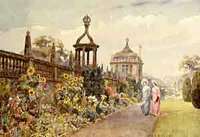The path has been steadily rising, and now the ascent is a little steeper. The character of the trees is changing; Oaks are giving way to Scotch Firs. Just where this change begins the bank to right and left is covered with the fresh, strong greenery of Gaultheria Shallon. About twenty years ago a few small pieces were planted. Now it is a mass of close green growth two to three feet high and thirty paces long, and extending for several yards into the wood to right and left. In a light, peaty soil such as this, it is the best of undershrubs. It is in full leaf-beauty in the dead of winter, while in early summer it bears clusters of good flowers of the Arbutus type. These are followed by handsome dark berries nearly as large as black currants, covered with a blue-grey bloom.
Now the path crosses another of the broad turfy ways, but here the turf is all of Heath; a fourteen-foot-wide road of grey-rosy bloom in August; and now we are in the topmost region of Scotch Fir, with undergrowth of Whortleberry.
The wood path next to this goes nearly straight up through the middle of the ground. It begins at another point of the small lawn next the house, and passes first by a turf walk through a mounded region of small shrubs and carefully placed pieces of the local sandstone. Andromeda, Skimmia and Alpenrose {Rhododendron ferrugineum} have grown into solid masses, so that the rocky ridges peer out only here and there. And when my friends say, "But then, what a chance you had with that shelf of rock coming naturally out of the ground," I feel the glowing warmth of an inward smile and think that perhaps the stones have not been so badly placed.
[Scotch Fir is also known as Scotch pine, Scots pine,or Pinus sylvestris]

